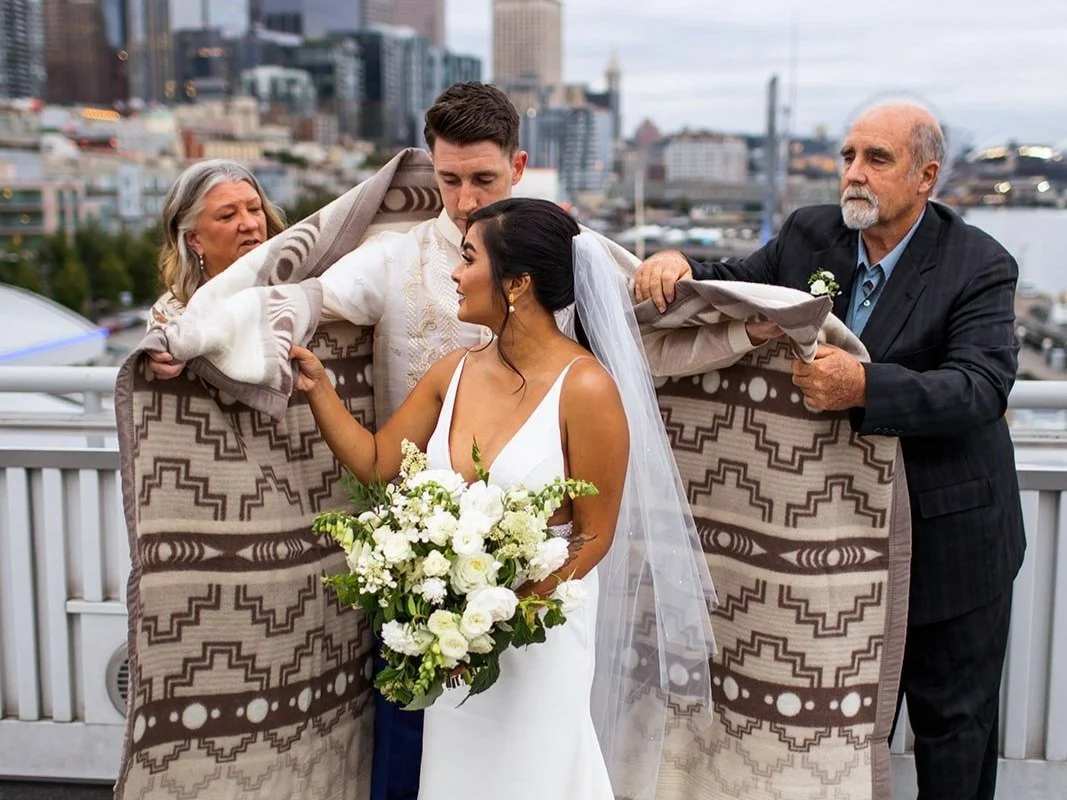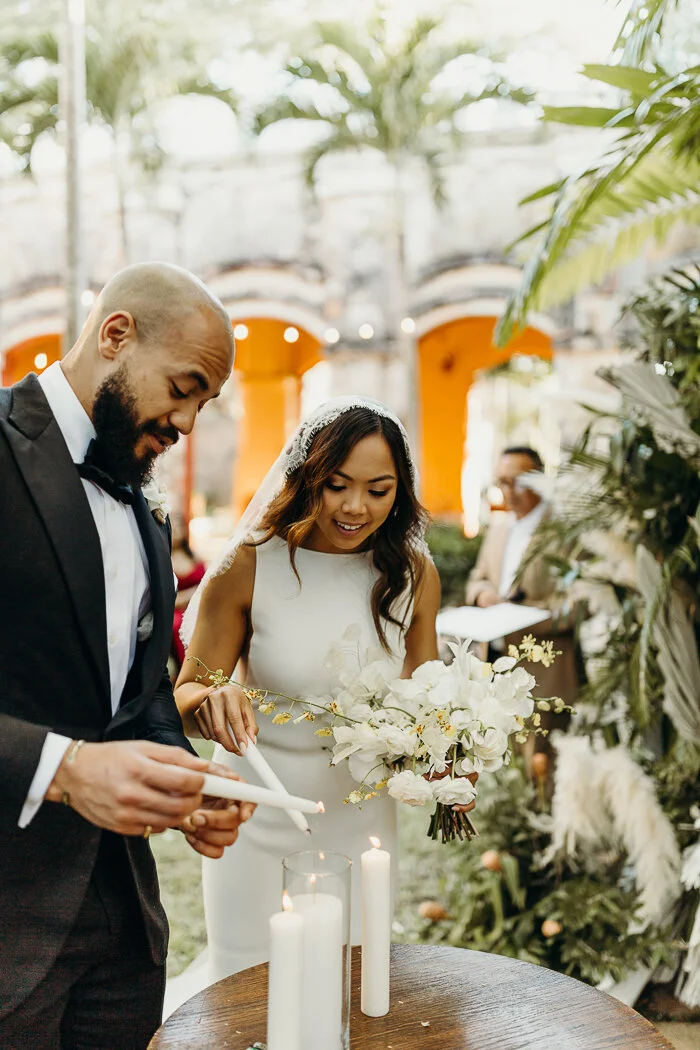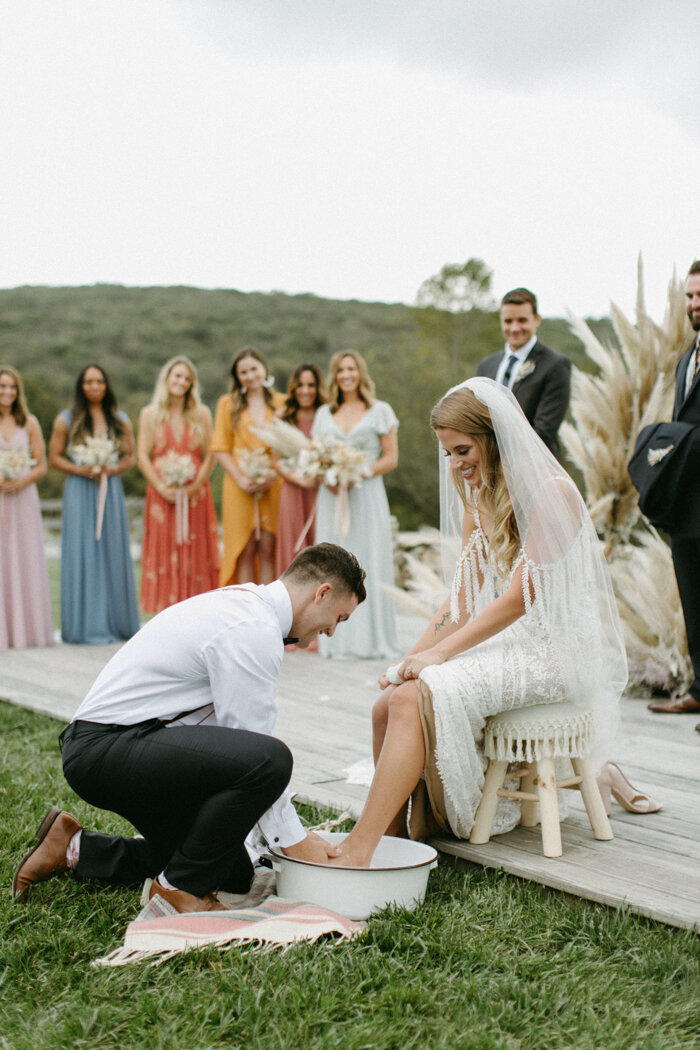Unity ceremonies are great to incorporate into your wedding day as a way to even more strongly symbolize your marriage union. While many wedding unity ceremonies come from ancient customs, there have been many new types introduced due to families of different ethnic and religious backgrounds coming together.
Brides and grooms often want to blend heritages and traditions to celebrate the merging of their two families. By addressing both family’s customs, blended unity ceremonies are a great way to pay homage and respect to important family members. There is no incorrect way to have a unity ceremony, and oftentimes, brides and grooms will ask family to join in on the rituals as a way of further encouraging both families to become one.
Releasing a wish lantern
Seemingly coming straight out of a fairytale, releasing lanterns into the sky actually is very common in Asian cultures. It used to symbolize letting go of fears and worries, but overtime, has morphed into sending up good thoughts, blessings, prayers, and wishes to the deities up in the sky.
This is a great way to gather all of your wedding guests after dark, and allow both secular and non-secular believers to come together to honor your new marriage. You can either have guests wish upon their lantern before the release, or attach notes with written messages. The lights floating up into the sky are meant to symbolize good luck, prosperity, and new beginnings for the newlyweds.
Lighting a unity candle
Being both simple and extremely meaningful, lighting a unity candle is one of the most common unity ceremonies performed. The candle-lighting ceremony involves the bride and groom lighting a candle using two other already-lit “family” candles, symbolizing two families coming together to start a new one. Traditionally, the family candles are lit by the mothers of the bride and groom.
For couples who want to incorporate other family members into this unity ceremony, this tradition can be easily altered to have more participants. If you have children, this is a great way to have them be an important part of your new marriage by giving them their own lit candle to hold. Lighting the unity candle is also a great ritual for microweddings, so everyone present can symbolically add light to your relationship.
Lasso ceremony (“El Lazo”)
Originating from traditional Latino cultures (most common in Mexico and the Phillipines), the “el lazo” ceremony is now commonly referred to in Westernized cultures as the lasso ceremony. This ritual occurs immediately after vows have been exchanged. The officiant or los padrinos (godparents) drape(s) a floral garland, lasso, rope, or rosary around the bride and groom’s shoulders, twisting it once in the middle to create an infinity symbol. The wedding lasso is meant to symbolize the couple’s union and love that will continue to grow stronger throughout their marriage.
The placement of the lasso is typically accompanied by a prayer, asking God to bless the union of the couple.
Handfasting
Originally symbolizing a couple’s engagement to one another in ancient Celtic tradition, the handfasting unity ceremony now symbolizes a different meaning: the joining together of two lives. In this ritual, the couple joins hands, followed by their officiant reading aloud vows while tying three ribbons (or cords) around the two pairs of hands - hence the now-common term of a bride and groom “tying the knot.”
Ancient custom is to keep your hands bound until midnight, but that would make it slightly difficult to navigate through the rest of your wedding day, so we encourage you to take it off at the end of your wedding ceremony. When you do remove it, however, it's encouraged to try to slip the ribbons/cords off with the knot still intact.
Pouring sand
As with the tradition of the lighting of the unity candle, the ritual of pouring different sands into a singular vessel is a great way to visually represent the merging of two families. The most common way to perform a sand-pouring ceremony is by starting off with two separate glasses of sand. During the ceremony, the bride and groom will take turns pouring their different colored sands into an empty vessel. After the ceremony, the newlyweds can display the decorative and symbolic art piece in their shared home.
Tree planting ceremony
For couples who are all about sustainability, giving back to the earth, and finding symbolism in nature, a tree-planting ceremony proves perfect for them. During this ceremony, the bride and groom take turns adding soil and water to the tree once it has been placed in the ground. This unity ceremony option is great for if the wedding ceremony is taking place outdoors in the backyard of a family home or estate, where it can be appreciated by multiple generations.
Tea ceremony
Rooted back to ancient Chinese wedding traditions, the tea ceremony is a gorgeous, public display of respect, loyalty, and acceptance. The newlywed couple serves tea to their elders after exchanging vows, typically beginning with the parents and in-laws (In Chinese culture, it is customary to serve your elders first), and sometimes even their grandparents, or aunts and uncles.
Immediately following the ceremony, the parents typically offer their wisdom to the couple and gift them lai see (red envelopes containing cash), which is meant to symbolize good luck and fortune. And the groom’s parents then gift the bride gold jewelry, which the bride is expected to put on right away as a sign of respect.
Including a spiritual moment
Incorporating spiritual practices into your wedding ceremony can be a great way for the bride and groom to share their connection to nature and to the divine with their guests. As with all unity ceremonies, how they wish to express this deep connection is up to them, but oftentimes may involve prayers, readings, and songs.
Foot washing ceremony
During a foot-washing ceremony, the bride and groom take turns washing each other’s feet. This practice stems from Christianity; Jesus washed the feet of his disciples as a symbol of his devotion to be humble as their leader and to serve his followers.
Aside from its Christian roots, the ritual of washing the feet of another exemplifies one’s love and humanity. It also serves as an act of caregiving, which is to be carried on throughout the marriage.
Warming of the ring
Originating from Irish wedding traditions, the wedding rings of the betrothed are either placed into a decorative box, tied together, or passed around as is. Wedding guests are asked to bless the rings with good thoughts, warm wishes, or a prayer when it is their turn to handle the rings.
Starting with the officiant, the rings are then passed to a guest, who then passes the rings along when they are done, and so on. Once the rings have been “warmed” by everyone present, the officiant then takes the rings and gives them back to the bride and groom to place on one another’s fingers.
This simple custom is a wonderful way to generate positive and communal energy, and works really well for both intimate weddings and ones of a larger scale.
Blanket unity ceremony
The custom of the bride and groom wrapping themselves in a symbolic quilt of blanket links back to Native American culture. The blanket represents warmth and unity that the newlyweds will bring one another. Blankets used in this unity ceremony traditionally are of blue and white colors. The blue resembles the couple’s respective past lives, whereas the white signifies filling their new life together with peace.
In the ancient Cherokee tradition, the blanket unity ceremony is slightly more ornate, with the bride and groom starting off individually wrapped in blue blankets. Once their officiant blesses their union. the couple is then collectively enveloped in a single white blanket.
Butterfly ceremony
Releasing butterflies as a grand finale to your wedding ceremony is a great way to symbolize your new beginning together. Not only is it a joyful experience for all witnesses, but is environmentally-safe and also helps to replenish the butterfly population.
Feel free to invite others to participate in the butterflies release, whether that be important wedding party members, or every guest present. Either way, everyone will love it.
Seven Steps
A common Hindu wedding tradition is often referred to as the “Seven Steps.” During this ceremony, the couple pledges their vows around the agni, a holy fire that is acting as witness to their union. The bride and groom then perform seven laps around the symbolic fire, each lap representing a specific pledge of marriage, which they recite while circling.
Photography Credits
1 Hunter Photographic| 2 Memory Box Photography | 3 Lacie Hansen | 4 Studio Brown | 5 Adri Mendez | 6 Not Available | 7 The Happy Bloom | 8 Memory Box Photography | 9 Michelle Lyerly | 10 Tricia Victoria Photography | 11 Char Beck | 12 Samantha Ruscher | 13 Corbin Gurkin














